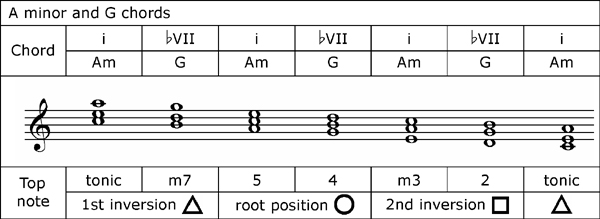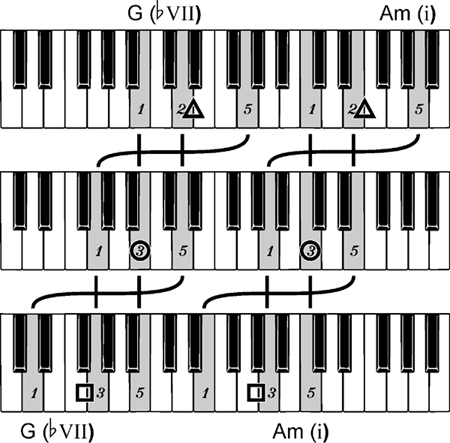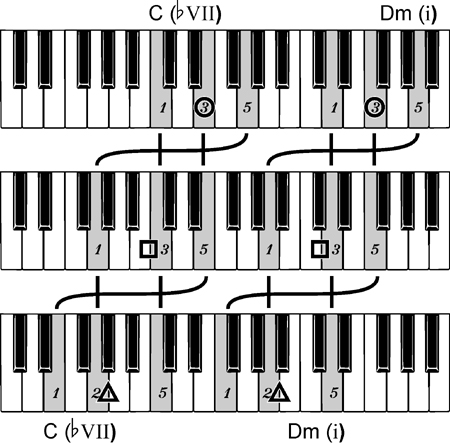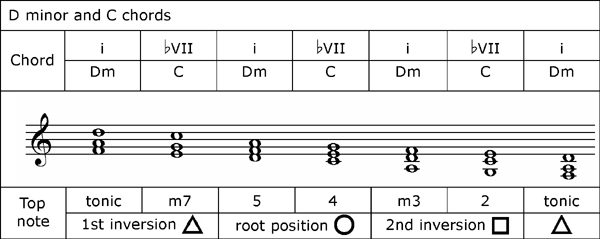The Musicarta Modes Workbook
The Minor
Modes (1)
This module starts our look at the minor modes. Here's the riff you build up to in this module.
Download up-to-date MIDI files for this page.
The i–ëVII (One, Flat Seven) pair
In both minor modes (Aeolian and Dorian) the all-important ‘five’ chord (the dominant) is minor, and this is considered weak as a cadencing chord. The major ëVII chord, which is available in both modal minors, often acts as a substitute.
Both the Aeolian and Dorian modes have this fruitful i-¨VII chord combination (highlighted in the table below) – the minor tonic (home chord) with a major chord a whole tone below.
Just as I and V in regular major keys (and i and V in the minor) can support lots of music on their own, so i and ¨VII in minor modes are a vital and fruitful pair of chords.

The module riff
Listen to the module riff again.
The riff uses the two pairs of i-ëVII chords that you can find using only white piano keys – A minor and G, and D minor and C.
Find the inversions of the A minor and G chords from the keyboard diagrams below..
At some point, you will want to study the tables you see one these pages. They may look very academic, but they contain a wealth of useful musical information.

The table tells you that six notes in the octave (the six top notes of the three inversions of the two chords) can be harmonised these two chords. In the tables, the ‘top notes’ are counted from the root of the A minor (home/tonic) chord.

Key to the symbols

The wavy line in the voice movement line diagrams clearly shows how the top note goes to the bottom (or vice versa) as you flip between inversions. Practice with the fingering in the keyboards diagram, to encourage a good hand position.
The inversions you see in the illustration could be played anywhere on the keyboard. The G chords you will play will be only one key below (to the left of) the A minor chords of the same inversion.
The chords in pairs
Find the descending string of eight alternating A minor and G chords. Use the triangle, circle and square symbols to help (even if you do read music). The pairs of A minor/G chords are the same shape, only one key apart.
The chords are written an octave higher than played, to save a lot of leger lines. To start building the riff, play the chords descending, an octave lower than written (8vb – start with the right thumb on middle C).

The riff has a ‘pedal bass’ – the note A repeated between the right hand chords regardless of what chord is being played above it.
The riff also has a jazzy beat – the music doesn’t show this. You can try to imitate it or just practice the chords straight, for now.
The D minor and C chords
Next, find the D minor and C chords. Use the keyboards diagram rather than the music even if you do read, to practice ‘seeing the music in the keyboard’. Remember that the keyboards diagram just shows what shape of chord to play, not where to play it.

Practise flipping through the inversions of D minor and C in the same way as before. Browse the table which follows to increase your stock of ‘really useful theory’.

Now learn to play the D minor and C Chords in exactly the same pattern as the A minor and G chords before

The D minor/C part of the riff comes half way through. The music is a bit simplified – it doesn’t show the jazzy beat..
The whole riff: AABA form
Listen to the module riff again, paying attention to its ‘shape’.
You hear:
- the descending string of eight alternating A minor and G chords twice, then
- The same eight-chord pattern using D minor and C chords, then
- The A minor and G string again, then
- An ‘outro’/ending.
(An ‘outro’ is the opposite of an introduction!)
Basically, we have one ‘thing’ (the A minor/G chords) twice, another thing (the D minor/C chords) once, then the first ‘thing’ again. (The outro is just tacked on.)
If we call the first thing ‘A’ and the second thing ‘B’, we have what’s called ‘AABA form’ – two ‘A strains’ (sections), one ‘B strain’ then another ‘A strain’. You’ll find AABA form a lot in music, especially in jazz standard songs. Listen out for it!
Putting it together
Your main aim is to practice efficiently so you achieve you goal as quickly as possible.
- Slow it down until you can play both eight-chord strings. If you can’t play one of them:
- identify which bit is difficult for you and what’s going wrong;
- fix that then integrate the repair back into the string of chords.
- Work on the jump from the A minor/G keyboard position to the D minor/C keyboard position and back (this would usually be a difficulty).
The main purpose of a riff like this is either to back a solo, or just to get into the groove and enjoy your own playing. Note that it’s fine to play the whole riff slower than the demo audio tracks.
More i-ëVII riffs
You can build up whole riffs, swapping between just two chords: Here are two ‘play by ear’ examples to copy. Use the MIDI clips to see exactly what is going on.
|
OUT NOW! |
THE MUSICARTA BEAT & RHYTHM WORKBOOK At last! An effective approach to keyboard rhythm & syncopation skills. Learn more! |
ONLY $24.95! |
MODES |
The MusicartaA methodical approach to keyboard syncopation for
|
PUBLICATIONS
exciting keyboard
creativity courses
CHORDS 101
WORKBOOK

~HANON~
video course

Musicarta
Patreon
PENTATONICS
WORKBOOK
video course

Creative Keyboard
video course

BEAT AND RHYTHM
WORKBOOK

- Volume 1 -

12-BAR PIANO
STYLES WORKBOOK

MUSICARTA MODES
WORKBOOK

PIANO STYLE

CANON PROJECT
video course

VARIATIONS
video course


- Piano Solo -
video course

- Piano Solo -


YouTube playlists





 THE LOGO
THE LOGO
